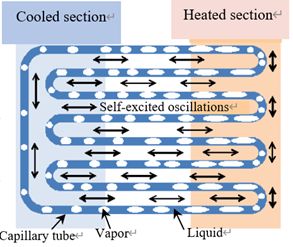 Home News
People
Highlights PHP Best Papers Our
Papers Diary Contact
us
Home News
People
Highlights PHP Best Papers Our
Papers Diary Contact
usA pulsating heat pipe (PHP) is a promising two-phase passive thermal device that consists of a capillary tube meandering between an evaporator (heating section) and a condenser (cooling section). The PHP is partially filled with a working fluid that exists as a mixture of liquid slugs and vapor plugs. Heat is transferred from the evaporator to the condenser by the self-excited oscillation of vapors and liquids. Compared with other two-phase passive thermal devices, such as conventional heat pipes and loop heat pipes , PHPs have many advantages, including having a simple construction, being lightweight and flexible, and having no internal wick structure because PHPs consist of meandering capillary tubes. Low-cost, commercially available tubes can be used for PHPs without special processing. Consequently, the manufacturing costs of PHPs are lower than those of other two-phase thermal devices. By increasing the number of turns in PHPs, the areas of its condenser and evaporator can be increased, increasing the heat transfer capacity of the PHP. Using PHPs in heat exchangers allows the development of equipment that is lighter and more compact, and thus PHPs may be suitable for cooling devices for electronics and microelectronics, biomedical devices, and space applications.

PHPs were invented in the 1990s and various experimental studies have been conducted to investigate the effects of changing the PHP configuration (shape, number of turns, pipe diameter, and length) and working fluid on thermal performance . The results showed that gravity and number of turns strongly affect the performance . In addition, the heat transfer performance is maximized at working fluid filling ratios of 40–60%, and a working fluid with a small latent heat and a large sensible heat has a higher heat transport capability . Although several studies have indicated that the PHPs are efficient for the cooling of the electronic devices such as laptop computer and LED (light emitting diode) , they have not yet been put to practical use and PHP is still at the level of laboratory-scale experimental study in relevant conditions. This is due to an incomplete knowledge of thermo-fluid dynamics governing the internal two-phase oscillating flow and therefore a lack of modeling tool to help the design and optimization of PHP. Theoretical studies have modeled the heat transfer phenomena and models based on a wave equation of pressure oscillation or thin-film evaporation and condensation have been proposed. However, the unified modeling for hydrodynamic and heat transport mechanisms, particularly at the operating limit of PHPs, is far from satisfactory. The operating limit of a PHP is the state where the working fluid inside the PHP does not undergo self-oscillation and the heat transfer from the evaporator to the condenser stops. If the heat input to the evaporator continues after the operating limit is reached, the evaporator temperature rises immediately and the internal pressure of the PHP also increases. In the worst case, this destroys the PHP. In addition, the equipment cooled by the PHP heats up due to the lack of heat transfer, which may cause serious damage to the equipment. Therefore, it is essential to design PHPs so they do not reach their operating limit during operation, especially in spacecrafts, which are difficult or impossible to repair once launched.
As already mentioned, PHP is not yet commercially available, but a number of potential applications have been proposed so far. We preseted ten of them in our first webinar on 27 July 2021. You can view and download the presentation file below.
potplos_webinar1.pdf This
project has received funding from the European Union's Horizon 2020
research and innovation programme under grant agreement No. 8947550.
This
project has received funding from the European Union's Horizon 2020
research and innovation programme under grant agreement No. 8947550.
This website reflects the views only of the author(s) and the European
Union cannot be held responsible for any use which may be
mage of the information contained therein.